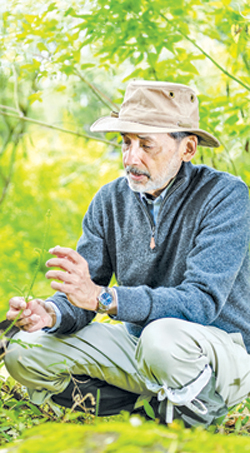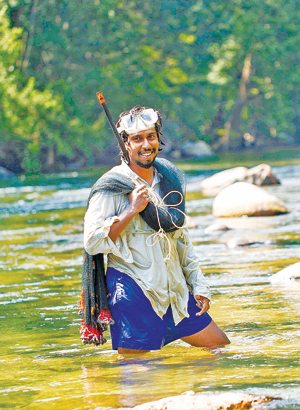A veteran naturalist and a young zoologist ‘go fishing’ to map out our biogeography

Out in the wilds : Rohan Pethiyagoda
Sri Lanka may not be a Madagascar or even a Tasmania but we are still a unique tropical haven for a dense biota.
Yet no naturalist hitherto has ventured on a quest to find how the isle came to possess its living legacy of fauna and flora.
This abiding enigma is taken up compellingly in Rohan Pethiyagoda and Hiranya Sudasinghe’s new volume- The Ecology and Biogeography of Sri Lanka: A context for freshwater fishes. The book is a comprehensive biogeography (a study of geographical distribution of plants and animals) of our island from the Gondwanan times.
The idea first swam up in 2015. While the basic facts of Sri Lanka’s evolution were known, there was simply no biogeographic framework for the island.
It was known that, together with India, we used to be a part of Antarctica until about 120 million years ago. Also that India-Lanka broke away from Antarctica and began drifting north, leaving “fragments” such as Madagascar behind. Finally, about 55 million years ago, India collided with Asia. But no one had attempted to build a model of how all these processes affected our biodiversity.
The collaboration of this book seems somewhat unusual: a well known veteran naturalist alongside a fresh-faced young zoologist still in his twenties (albeit reading now for his PhD). But this symbiosis has proven to be a roaring success: Hiranya enthusiastically took to the fieldwork, hunting down freshwater fishes in sun-dappled or gushing broad-banked rivers- in the course discovering many a new species; while Rohan had his own role to play.
But why concentrate on freshwater fishes in order to map the biogeography of our island?
Explains Rohan, “Freshwater fishes can’t cross oceans and they can’t fly. If a fish gets from India to Sri Lanka, it means there must have been a land connection sometime in the past. By using molecular clocks, Hiranya was able to estimate when these connections existed. This work also sheds light on how and when fish migrated across the island after they crossed the land bridge from India.”
Some 800 scientific publications were analyzed- all referring to the distributions of plants and animals in Sri Lanka, India and other places. They were intrigued to come across many ‘disjunctions’- for example how certain plant or animal groups occur in Sri Lanka and Borneo, but nowhere in between.

Hiranya Sudasinghe
“For example, the endemic rainforest land snails of the family Acavidae occur in Madagascar and Sri Lanka, but not in India. Interestingly, the same is true of the humble ‘diyapara’ tree! Analysis of this massive dataset helped us find common strands of evidence, which we used to build up a model.
“This is still crude, but at least now, we have some hypotheses that can be tested.”
The rather exciting biogeographic framework Rohan and Hiranya came up with is basically this:
“Around 65 million years ago, Earth suffered the so-called K-Pg extinction. The vast majority of species became extinct, including the dinosaurs. Except for a few groups of animals that live mainly underground or on the forest floor, Sri Lanka too, seems to have been wiped clean. The handful of survivors include groups such as some spiders, forest scorpions, and among vertebrates, only a single group each, of frogs and snakes. No mammals, fish or birds, as far as we know.
“Even more recently, the island encountered massive extinctions, probably from aridification. Therefore, the vast majority of Sri Lanka’s plants and animals are Asian in origin. They dispersed from tropical Southeast Asia, across India, and into Sri Lanka when sea levels were low enough for a land bridge to emerge between India and us. The earliest land bridge was probably around 28 million years ago, and the most recent probably ended just 6,000 years ago.”
Of course, the picture is not all complete.
“The biggest gap is the lack of good data from Southeast India (from where) pretty much every species of plant and animal that entered Sri Lanka came from.”
Many of these groups were to become extinct in India due to aridification while the wet zone of southwest Sri Lanka has persisted for at least 30 million years – which is how we have preserved our extraordinary rainforest biodiversity.
 The book, Rohan is justly proud to say, has already been a wake-up call to Indian scientists.
The book, Rohan is justly proud to say, has already been a wake-up call to Indian scientists.
The rainforest floor- a habitat most people ignore- is full of creatures who tell us a lot about Sri Lanka’s deep history prior to about 30 million years, says Rohan citing forest scorpions, spiders, giant centipedes and water beetles.
This has been always lamented by Rohan; the human obsession with charismatic mammals overlooking the conservation of animals that can be so much more intriguing.
“When I go to Yala, I’m not so interested in seeing elephants, bears and leopards. After all, you can see these anywhere in tropical Asia. Instead, I’d love to catch a glimpse of ‘Leleuporella sexangulata’, a tiny endemic beetle whose closest relative is not anywhere in India or Asia but in the Congo!”
“Our book includes photos of many of these ‘biodiversity gems’ and explains why each one is so special. The endemic ant ‘Aneuretus simoni’, for example, is among the most remarkable insects on the planet. I would like to see one day a special display of these fantastic creatures in the zoo, a kind of Sri Lankan Jurassic Park.”
But insidiously the very forces that made Sri Lanka a biodiversity hotspot-climate and sea level also can be the undoing of our biota: While Sri Lanka’s wet zone is the wettest region between equatorial Africa and Sumatra, and more than 80% of our endemic species occur only there, less than 5% of this zone is forested- an area smaller than Yala.
Meanwhile climate change is causing the highlands to dry up: rainfall in Nuwera Eliya has reduced by more than 20% in the past 150 years, while average temperature has risen by almost 1.5° Celsius.
Rohan clearly sees it’s the time to push the button.
“We’re seeing a new mass extinction happening right before our eyes,” he stresses. “We need to deploy our best science and scientists to devise interventions to mitigate that. It’s a massive challenge…”
| Tracking down journeys of aeons ago | |
| Painstakingly put together, the book is replete with underwater photography by Hiranya and splendidly illustrated while the absorbing narrative of island evolution will fascinate scientists, students as well as enthusiasts of Sri Lankan biodiversity.On the hunt for the captivating images and specimens in hundreds of locations, Hiranya was to discover new species- among them a beautiful fish he named ‘Devario memorialis’, while also rediscovering ‘Labeo lankae’, a rare fish thought to be extinct. As Lukas Ruber notes in his Foreword, the book also has the charms to tip ‘The Resplendent Isle’ to the top of anyone’s travel bucket list. |
Searching for an ideal partner? Find your soul mate on Hitad.lk, Sri Lanka's favourite marriage proposals page. With Hitad.lk matrimonial advertisements you have access to thousands of ads from potential suitors who are looking for someone just like you.


